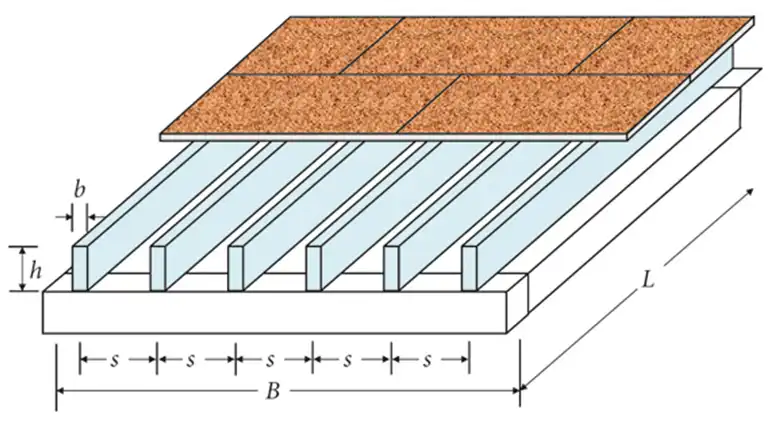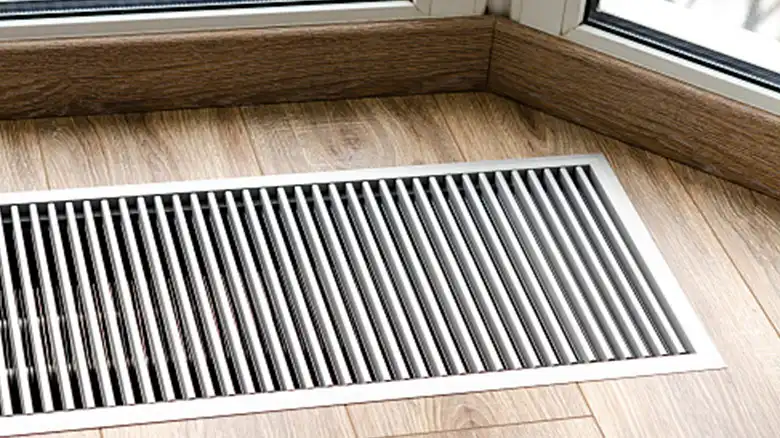Natural frequency is a property of a vibrating object that depends on its mass, stiffness, and damping. It is expressed in Hertz (Hz), which is the unit of frequency that indicates the number of vibrations per second. Generally, the frequencies are between 1.0 and 3.0 Hz (1/s), which are normally well below the most common resonance frequencies for floor constructions. The mass of the floor determines the natural frequency of a floor system, the stiffness of the floor material, and the structural elements supporting the floor. The calculation of natural frequency can be done using mathematical equations that consider these factors.

How Does the Natural Frequency of Floors Work?
Natural frequency is a crucial factor to consider in building design, especially for floors. It refers to how quickly an object vibrates when not forced to do so externally. Natural frequency affects how floors respond to vibrations, such as foot traffic, machinery, or earthquakes. This article will discuss the definition, factors affecting natural frequency, its importance in floor design, and ways to measure it.
Factors Affecting Natural Frequency of Floors:
Let’s dive into the factors affecting the natural frequency of floors in more detail. By understanding these factors, one can make informed decisions in designing and constructing safe, durable, and efficient floors.
Factor 1. Structural Material:
The type of material used to construct the floor, such as concrete, wood, steel, or composite materials, can affect its natural frequency. Different materials have different stiffness and mass properties influencing the floor’s response to dynamic loads.
Factor 2. Floor Thickness:
The thickness of the floor slab is a crucial factor in determining its natural frequency. Thicker slabs are stiffer and have a higher natural frequency than thinner slabs.
Factor 3. Floor Span:
The distance between supports or columns that hold the floor system can affect its natural frequency. Longer spans tend to result in lower natural frequencies, while shorter spans tend to have higher ones.
Factor 4. Load Distribution:
How loads are distributed across the floor system can also affect their natural frequency. A uniform distribution of loads results in a higher natural frequency than a concentrated load.
Factor 5. Damping:
Damping is the ability of a system to dissipate energy and reduce oscillations. Higher damping results in lower natural frequencies, while lower damping results in higher ones.
Factor 6. Boundary Conditions:
How the floor is attached or supported at its edges or boundaries can also affect its natural frequency. Fixed boundary conditions result in higher natural frequencies than free or hinged boundary conditions.
Factor 7. Deflection Criteria:
The maximum allowable deflection of the floor system can also influence its natural frequency. A more rigid floor system may have a higher natural frequency but may only be desirable if it can meet deflection criteria.
Factor 8.Construction Tolerance:
The construction’s precision and accuracy can affect the floor system’s natural frequency. Small variations in the size or shape of the floor elements can lead to differences in the natural frequency.
Factor 9. Temperature and Humidity:
Changes in temperature and humidity can also affect the natural frequency of the floor system. Higher temperatures tend to increase the natural frequency, while higher humidity can decrease it.
Factor 10. Structural Modifications:
Changing the distribution of loads or adding additional supports to the floor system can also alter its natural frequency. It is essential to evaluate the effect of any modifications on the natural frequency to ensure that the floor system remains stable and safe.
Important Note: The natural frequency of a floor system can be calculated using the following formula: f = 1 / (2π) x √(k/m). This formula calculates the natural frequency of a simple harmonic oscillator, which is a model that approximates the behavior of a vibrating floor system.
Importance of Natural Frequency in Floor Design:
The natural frequency of a floor system is crucial in the design process, impacting comfort, safety, and performance while also affecting the building’s cost and construction time. This section will highlight the significance of natural frequency in floor design.
Importance 1. Occupants’ Comfort
The natural frequency of a floor system directly impacts the comfort of building occupants. Floors with a high natural frequency tend to vibrate less in response to external forces, providing a more stable and comfortable environment for people to walk, work, and live in.
Importance 2. Structural Integrity
The natural frequency of a floor system is also critical in ensuring its structural integrity. If the floor’s natural frequency matches the external forces’ frequency, such as wind or earthquakes, resonance can occur, leading to excessive vibrations and potential structural damage. By designing the floor system with an appropriate natural frequency, engineers can ensure the safety and durability of the building.
Importance 3. Noise Reduction
Floor systems with a low natural frequency tend to have higher sound transmission levels, which can lead to noise pollution within a building. By designing a floor system with an appropriate natural frequency, designers can reduce the transmission of sound waves and improve the acoustic performance of the building.
Importance 4. Machinery and Equipment:
The natural frequency of a floor is crucial in designing machinery and equipment installation within a building. Equipment has varying natural frequencies, and it’s important to avoid resonance with the floor system’s frequency. This prevents excessive vibrations and potential equipment failure.
Importance 5. Cost Savings:
Designing a floor system with an appropriate natural frequency can also save costs. By optimizing the thickness and stiffness of the flooring material, engineers can reduce the amount of material needed while still maintaining the required natural frequency. And this can result in lower construction costs and reduced energy consumption over the life of the building.
Methods for Determining Natural Frequency of Floors:
The natural frequency of a floor is an important parameter that helps determine its dynamic behavior and response to various types of loads. There are several methods for determining the natural frequency of floors, including experimental and analytical approaches. In this response, I will provide a brief overview of some of these methods.
Method 1. Analytical Calculation
A mathematical method for determining the natural frequency of floors by modeling the floor system as a simple beam or plate and solving the corresponding differential equations using analytical methods.
Method 2. Empirical Measurements
Directly measuring the natural frequency of a floor system using specialized equipment by inducing small vibrations and measuring the corresponding frequency response using a vibration sensor.
Method 3. Finite Element Analysis
A numerical method for determining the natural frequency of floors by dividing the floor system into small elements and solving the corresponding differential equations using numerical methods.
Method 4. Field Measurements
Measuring the natural frequency of a floor system in situ, under actual operating conditions, by installing vibration sensors on the floor and measuring the vibration response to external forces.
Natural Frequency Floor Advantages and Disadvantages
Understanding the advantages and disadvantages of designing floors with consideration of natural frequency is important in building design. Here, we will discuss the benefits and drawbacks of considering natural frequency in floor design.
Advantages
- Seismic Performance: In areas with high seismic activity, designing a floor system with a low natural frequency may be desirable to improve the building’s seismic performance. A low natural frequency can provide greater resistance to seismic forces, reducing the risk of damage or collapse during earthquakes.
- Human Perception: In some cases, building occupants may perceive a floor system with a lower natural frequency as more comfortable. A floor system with a higher natural frequency can feel more rigid and bouncy, while a floor system with a lower natural frequency can feel more flexible and absorbent, reducing the perception of vibrations and impact forces.
- Acoustic Performance: A floor system with a lower natural frequency can also provide better acoustic performance by reducing sound transmission through the floor. And this is especially important in buildings where noise reduction is a critical design consideration, such as music studios, theaters, or libraries.
Disadvantages
- Excessive Deflection: A floor system with a low natural frequency can exhibit excessive deflection under certain loading conditions, such as heavy foot traffic or equipment loads. And this can lead to reduced comfort, increased noise transmission, and potential damage to the floor system.
- Cost and Complexity: Designing a floor system with a low natural frequency can be more costly and complex than designing a floor system with a higher natural frequency. And this is because it often requires specialized materials, construction techniques, additional structural support, and damping elements.
Frequently Asked Questions and Answers
How can the natural frequency of floors be reduced?
The natural frequency of floors can be reduced by increasing the stiffness of the floor system or by adding mass to the floor. And this can be accomplished through the use of thicker or stiffer flooring materials, the addition of underlayment or subflooring, or the installation of damping materials.
What are the potential risks associated with high natural frequencies in floors?
High natural frequencies in floors can result in uncomfortable levels of movement or vibration for occupants, which can lead to discomfort, motion sickness, or even injury. In addition, high natural frequencies can cause damage to sensitive equipment or machinery located on the floor.
Can the natural frequency of a floor be changed?
Yes, the natural frequency of a floor can be changed by altering the stiffness or mass of the floor system or by adding damping elements such as insulation or soundproofing materials. However, these modifications must be carefully planned and executed to avoid creating other problems, such as increased weight or reduced structural integrity
Conclusion
In conclusion, the natural frequency of floors is a critical aspect of building design that requires careful consideration and analysis. By understanding this parameter and taking appropriate measures to mitigate its effects, we can create buildings that are not only safe and functional but also aesthetically pleasing and sustainable.





